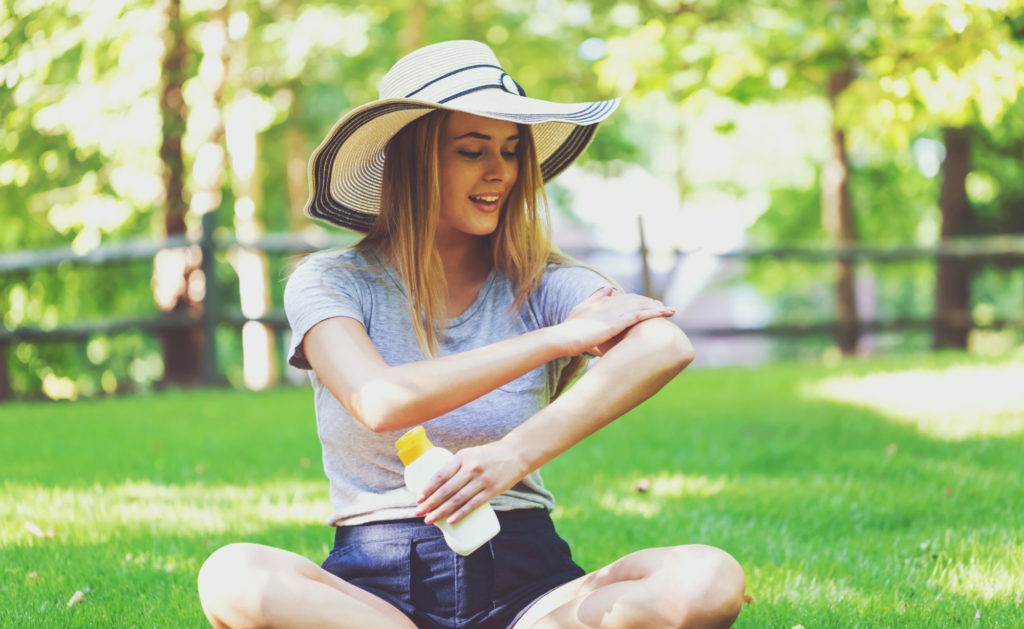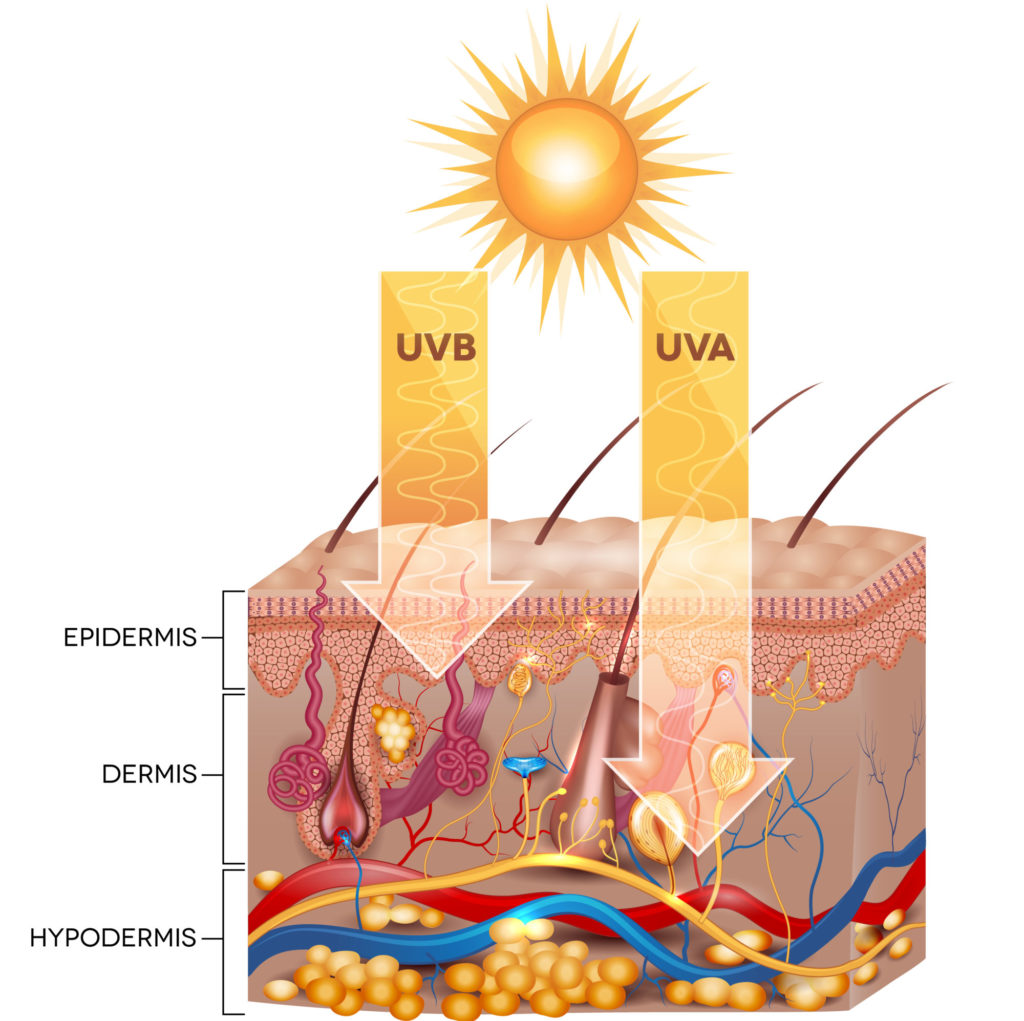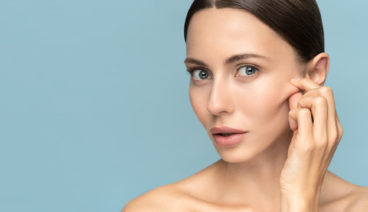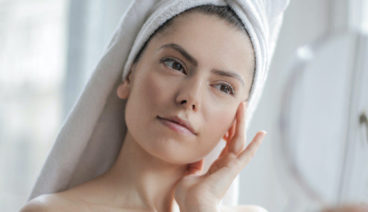Sunlight is good, that is a certainty. Good for the mood, good to synthetize vitamin D, chlorophyll, oups it is not about us, except in chewing gums 😁, and a lot of molecules necessary for life. But UV rays cause many damages from painful burns to DNA damages.
Well, how to associate the good and the bad to get the maximum benefit of sunlight ? Everybody is thinking: with sunscreens, silly 😎
Yes, obviously 😏 but how do sunscreens protect our skin exactly and which skin compartment need to be protected?

Sunlight is partly composed by UVB and UVA photons
UVB photons emit in a shorter wavelength and don’t penetrate deeply into the skin but induce damage to DNA, aim to sunburn and are the primary cause of skin cancer. UVA photons emit in a longer wavelength and penetrate the deeper layers of skin. Those are the cause of free radicals’ production, and it has been shown that they cause premature skin aging and immunologic problems.
Then, is it enough to use sunscreens that act like a shield in stopping UV rays to reach any skin compartments?
The term SPF used for sunscreen labels means Sun Protection Factor, but it is more a sunburn protection factor as the FDA states: “SPF is a measure of how much solar energy (UV radiation) is required to produce sunburn on protected skin (i.e., in the presence of sunscreen) relative to the amount of solar energy required to produce sunburn on unprotected skin. As the SPF value increases, sunburn protection increases.”
A quick explanation about what does SPF exactly mean
An SPF 10 sunscreen allows 10 out of every 100 photons to reach the skin and an SPF 20 product allows only 5 out of every 100 photons to reach the skin. That means that an SPF50 will absorb 98% of UVB.
Well, it’s good but not enough for an effective sun protection. Sunscreens must deliver true broad-spectrum protection because effects of UVB and UVA are different.

How do UVB rays affect skin?
UVB rays provide the energy your skin needs to make Vitamin D; they simulate the production of melanin which is responsible for tanning. They don’t travel as deeply as UVA rays, penetrating only the outermost layers of skin (the epidermis), but they cause more immediate damage such as sunburn and can cause skin to thicken temporarily. UVB rays are directly absorbed by cellular DNA and can lead to skin diseases such as actinic keratosis and skin cancer.
UVB rays (as well as UVA and HEVIS) can induce hyperpigmentation.
How do UVA rays affect skin?
UVA rays penetrate the deeper layers of skin (the dermis). They stimulate the production of free radicals in the skin which cause oxidative stress and can lead to indirect DNA damage: (where the free radicals modify cellular DNA over time). UVA rays are most associated with:
- Photoaging (premature skin aging caused by the sun)
- Sun allergies such as PLE (UVB rays can also provoke allergies, but to a lesser degree)
- Hyperpigmentation such as sunspots (also known as age spots)
So clearly, sunscreens are essential for an healthy skin but more and more complicated to develop to obtain this so important large broad-spectrum sun protection.
How do we evaluate sunscreens’ efficacy?
The basic value for in vivo tests is the Minimal Erythema Dose (MED), which is defined as the threshold dose of solar radiation that produces sunburn. Then, that test only predict UVB protection (UVB-PF).
The UVA protection Factor (UVA-PF) comes from in vitro measurements and there are several methods based on UV transmittance measurements of a thin layer of sunscreen.
But at the end, the most popular index is the SPF. Nevertheless, higher SPF leads to a false sense of skin protection because quantities applied are usually much lower than needed and therefore the “true” SPF is much lower. Indeed, according to SPF recommendation and “Considering that a normal-sized adult skin measures 2 m2, an adult whose height is 1.73 m would require 35 g of sunscreen per application, which a very small percentage of the population employs.”(1)
There is a tremendous need for supportive methods that measure beyond erythema, given the steady increase in diagnosed skin cancer cases over the past 10 years, not automatically linked to erythematous reactions. Furthermore, it would be great to perform in vitro tests for photoprotective efficacy, to reduce variability and avoid human volunteers who receive high doses of light in the UV and other ranges. Eventually, sunscreens have been shown only to help prevent sunburn, not photoaging or even skin cancer.
Thus, what can we do 😨?
Sunscreens not only have to include UV filters but also active ingredients protecting against DNA damage, collagen degradation or immunosuppression for example.
Fortunately, many brands have understood this challenge and already develop multifunctional sun care products.
The last part, but not the least and the most difficult, would be to combine SPF measurements with these new methods to provide a safe sun protection index.
(1) Expert recommendations on the evaluation of sunscreen efficacy and the beneficial role of non-filtering ingredients
Discover our solutions
Blue light
Anti-aging and regenerating effect
Collagen disks
Follow our other news
The relationship between skin elasticity and viscoelasticity
 24 January 2024
24 January 2024Are you a smoker? Here’s how it affects your skin!
 29 November 2022
29 November 2022Why are simplicity and multifunctionality new trends in the beauty market?
 19 October 2022
19 October 2022






